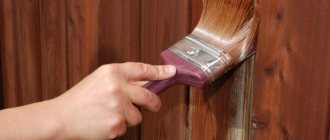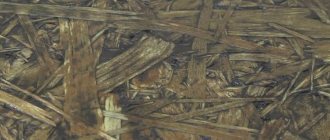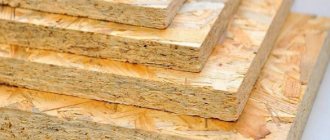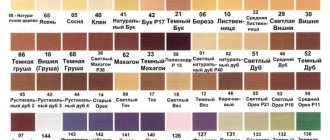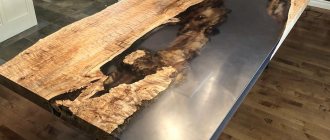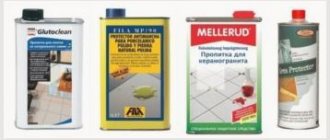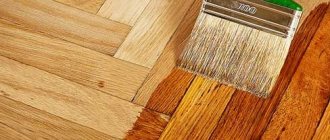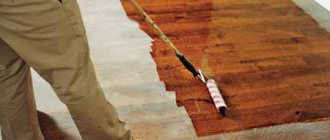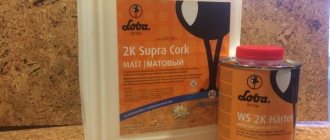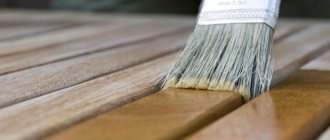OSB sheets, also known as OSB boards, are increasingly used for arranging walls and interior partitions in houses. Not surprising, because it is a lightweight, inexpensive and very practical building material. Therefore, the question of their finishing arises. Here we will look at the main methods of finishing walls made of OSB sheets inside the house.
You can learn about methods for finishing OSB sheets outside the house in a separate article: finishing OSB walls outside the room.
You can read about the technology of attaching OSB boards to walls inside a house on the page: technology of covering walls with OSB boards inside a house.
More details about what OSB or OSB boards are can be found in a separate article: what OSB sheets are, their types and characteristics.
Expert opinion
Strebizh Viktor Fedorovich, leading construction foreman
It prevents the material from fading, as it contains special components that can withstand exposure to the sun. If you want to clarify something, please contact me!
Preparation and application of coating
The real difficulties begin precisely at this stage - the entire area of the floor has to be processed before further actions. Before coating with varnish, careful sanding of the entire surface to be treated with sandpaper is necessary. If OSB-3 panels are used, then they immediately have well-polished front sides and additional processing will only be required at the joints of the parts.
All seams and joints should first be sealed with special sealants suitable for wood. It is advisable to use acrylic compounds. The sealed seams are sanded. Next, the required number of layers of varnish are applied with intermediate drying of each and final polishing. It will be better if you use oil- or acrylic-based varnish for a ceiling assembled from OSB - these compositions do not cause swelling of the material.
With coloring, everything is a little more complicated. You will need to pre-treat the entire surface with primer mixtures, and only after they have dried, apply the first layer of the finishing coat. Before priming, all joints or seams between adjacent structural elements are also treated with sealant and sanded.
When applying varnish or paint, special attention should be paid to the edges and adjacent areas of the panels. They need to be rounded, removing sharp edges and filling the resulting depressions with putty.
After puttying and sanding, it is necessary to prime the entire surface again and only after that begin painting.
If the plane is uneven, then you will need to not only putty the seams, but also treat the entire area of the future ceiling structure with putty. The technology for applying putty and sanding it is carried out using the same technology as when working with conventional bases. Applying a thick layer of putty mixture involves using a paint mesh to strengthen the coating.
About choosing a coloring composition - what to consider
This is not about the fact that the types of coloring compositions are very insignificant - on the contrary, there are a lot of types of paints. However, not all paints can be used to paint OSB boards. The characteristics of the material must be taken into account. For example, the material has a pronounced texture. Individual chips and many other features are clearly visible on it. But that is not all! There are other points that need to be taken into account when choosing a paint composition for OSB boards.
Let's start with the fact that OSB boards need pre-treatment. Without it, the coloring composition will not adhere well to the surface, and the coating will be uneven. This is because the surface of wood boards has extremely poor adhesion. This happens in most cases due to the fact that the slabs are treated with special impregnations, which also form a protective film on the surface.
You should also understand that it would be a bad idea to paint OSB boards with water-based paint. After all, we are talking about natural wood, and when it comes into contact with too much moisture, it is prone to swelling. Therefore, paints containing water are not suitable for painting OSB boards.
It is also worth considering the fact that OSB boards are characterized by increased roughness. This means that painting them will require quite a lot of coloring composition. Therefore, you should not calculate consumption using conventional formulas. They will not work with OSB boards.
Let us assume that the coloring composition was chosen according to all the rules, but when painting the slabs it still does not adhere well to the surface. What could be the problem? It may be that the wood material was stored in violation of the rules. If OSB boards have been left outdoors for more than one year, then the first step is to clean them of dust and other contaminants. After this, their surface must be sanded and coated with antiseptic compounds.
Finally, we would like to add that the ends of OSB boards require more careful painting. This is because they have a more porous structure, which means that when painting, all existing voids should be carefully filled. Naturally, this also leads to excessive paint consumption. To avoid this, you can pre-treat the ends and seams of the trim.
In general, OSB chipboards are an excellent material for finishing and construction!
Laying OSB on a wooden floor
How to finish an OSB slab on the outside
Wooden floors have unevenness, crookedness, and generally become unattractive over time. If you are a wood lover, there is no point in restoring such a floor, as this is fraught with costs, both financial and physical, if you decide to finish it yourself.
Therefore, almost every person prefers to lay floor finishing using modern materials.
Preparing a wooden floor for laying OSB is a very important criterion.
What is OSB
OSB is a particle board consisting of compounds of wood chips and an adhesive mixture, pressed into shape in the form of flat sheets of specified sizes and thickness.
A smart technology for gluing several layers of sheets consists of laying them transversely, which makes this product durable.
In order not to be mistaken with the choice of flooring, we will consider three types of OSB
OSB 1 is the lowest density material, and it is not difficult to cause wet damage. This type of board is mostly used in the furniture industry.
The components of the OSB 2 list are sheets of pressed chips intended for use in dry rooms. When OSB 3, on the contrary, is resistant to moisture and is suitable for finishing floors in the bathroom and kitchen.
OSB 4, whose thickness is 25 millimeters for less suitable flooring, is applicable in the construction of load-bearing structures.
Leveling a wooden floor
Leveling wooden boards of an old floor is done using various materials and you can choose any of them.
When compared with chipboard and fibreboard, OSB is quite durable boards, as thick as possible in width, based on the product category.
So, correcting the curvature of a wooden floor with your own hands will not be a difficult task. They are very convenient and easy to install and do not require any equipment.
Otherwise, fungi and mold will continue damaging processes under the new floor covering. Do you need it?
Before such a procedure, it is necessary to dismantle the old coating, leaving only the logs and laying thicker OSB.
After preparing the floor, begin laying OSB. You should start from the flattest corner of the room. To achieve a clear fit of the material, it is better to trim the slab on one or several sides at once.
OSB is fastened using nails and self-tapping screws, taking into account a distance of 35–60 cm between them. To achieve a better quality coating, then fix the material not along the perimeter, but also diagonally of the product.
Types and applications
Such slabs are used not only for leveling floors, but also in many other construction areas. So, we can say that the scope of application of the material largely depends on its type. The main categories are shown in the table below.
They are used in the construction of frame houses
Table. Types of OSB.
| Type | Characteristics |
| OSB 1 | This slab has modest density characteristics, but it is less susceptible to water than other types. It is usually used for interior finishing of premises, and is also suitable for leveling floors. |
| OSB 2 | This type is not characterized by increased moisture resistance, but has high strength. So usually such a slab is suitable for arranging floors or partitions indoors. |
| OSB 3 | This type combines a good level of moisture resistance and strength. The plate is suitable for both internal and external types of work. Not a bad option. |
| OSB 4 | This is a slab that is most often used for the construction of load-bearing walls, roofs, and a number of similar structures that must be powerful and durable. All her main physical characteristics are at the highest level. |
The thickness of the slabs usually varies between 8-26 mm. Typically, it is the thickness that indicates the main purpose of the material. For finishing options where no special load is expected on the surface, thin slabs are suitable, but where there will be a large load, it is worth laying thicker slabs. For a floor with a concrete screed, you can take material from 10 mm.
The thickness of the slabs can also vary
You can level floors using OSB not only along the screed, but also along the joists, and make a dry screed. In this case, the slabs need to be thicker. Sometimes sheets are mounted in several layers.
Scope of use of OSB material
How to paint the panels outside
Finishing stone for walls inside an apartment: maximum effective use
Painting slabs outside
For external finishing work - finishing the facade, installing partitions and floors - oriented strand boards are coated with impregnations, varnishes and paints:
- alkyd
- oil
- water-based
- acrylic
- latex
When choosing a material for painting, it is better to choose compositions that contain special additives that protect the slabs from exposure to UV radiation.
The coating must also be vapor permeable, otherwise mold will form on the slabs. An impermeable coating can cause warping of sheet building materials.
Alkyd paint
Alkyd paint
Alkyd paint
It contains plant resins, film formers (glyphthalic or pentaphthalic), pigments, purified kerosene, fillers and antiseptics. After coating and drying, a film remains on the surface of the material, which provides additional strength to the OSB.
Dries quickly, is non-toxic, creates a waterproof layer, protects against temperature changes. However, it has a pungent odor and is prone to fire.
If such a composition is applied to the slab before it dries completely, bubbles and peeling will form on the surface. This coating significantly reduces finishing costs, because the alkyd composition eliminates finishing impregnation with varnish.
Water-based mixture
Water-based paint
Water-based mixture
The two-phase mixture includes water and acrylic, fillers, film formers, pigments and a number of functional additives. After drying, the water evaporates, and the polymer layer gives the slab improved performance characteristics.
In addition to such advantages of paint as quick drying, non-toxicity and lack of a strong odor, the advantages include:
- low price
- variety of colors
- high resistance to fire and moisture
- ease of application
- service life up to 10 years and above
External work is carried out at a temperature not lower than +5. In the cold the composition becomes unusable.
For finishing, water-dispersion relief paint with the addition of marble dust or fine chips is also used. Its cost is higher than that of traditional water-based paint, but due to the relief it produces a beautiful decorative look.
Latex composition
Latex composition
Latex composition
A type of water-based paint, but instead of acrylic, the binder is a latex additive (based on vinyl, polyvinyl, silicone). The composition is elastic, viscous and durable, giving the surface characteristics of resistance to moisture, aggressive chemicals, UV radiation and temperature changes.
The paint is non-toxic and has no unpleasant odor. Using latex, you can get both a smooth and textured coating.
Acrylic based coating
Acrylic copolymer paints
Acrylic based coating
Such raw materials cover the unevenness of the structure well and give a uniform tone. It consists of polymers, water and dye, and after drying it leaves a durable film on the surface of the material. It can be matte or glossy; there are many colors in the assortment that do not require additional tinting.
The acrylic composition does not spread, does not fade, dries quickly, has the ability to allow steam to pass through, but is resistant to moisture. It is often used for interior work because it is non-toxic and does not emit harmful substances into the atmosphere when heated.
Oil paint
Oil paints
Oil paint
Raw materials using drying oil are rarely used due to their high toxicity and long drying time.
The oil composition leaves a lot of streaks and unevenness, while the coating does not last long, quickly crumbling and peeling off from the surface.
Doors for wardrobes: step-by-step instructions for calculation, assembly and installation with your own hands (Photo & Video)
Primer paint designed specifically for application to OSB boards
In addition to universal paints for all types of wood, there are compositions specifically designed for painting OSB. They are usually called primer paint and have the following features:
- They are able to create reliable protection for oriented strand boards from external influences of moisture and ultraviolet radiation.
- The composition has excellent adhesion properties to the surface of such plates.
- High elasticity and vapor permeability are noted.
- The density of the layer prevents the natural color of the OSB from showing through.
- Primer paint is produced in a basic white color and can be tinted to the desired shade.
- Primer paint is an environmentally friendly composition. It is made on a water basis with the addition of a special acrylic polymer, mineral fillers and antiseptic additives.
The primer can be used as a base coating, or to prepare the surface for the subsequent application of a decorative layer.
Criteria for choosing paint for interior work
When choosing a composition for painting OSB indoors, you need to consider some factors:
- The type of wood chips and type of binders used in the production of strand board.
- Decorating method, that is, it is planned to preserve the structure of the surface of the slab, or to make it smoother.
- Area of application (floors or walls).
- Features of the room in which installation will be carried out.
Paint should be selected based on the following recommendations:
Coloring and its advantages
How to paint plaster on a ceiling with what
Painting OSB has the following advantages:
- paint protects the material from moisture;
- hides the OSB texture;
- prevents cracking and deformation of products;
- It is simple and inexpensive.
The layer of applied paint does not allow moisture to penetrate into the thickness of the finished material. Without moisture, the slab does not warp. The chips used to make the slab are quite large. You can hide them with dyes. This is much cheaper and easier to do than using decorative panels. But the painting method can only be used indoors. After painting the OSB surfaces, they are varnished. The varnish protects the paint from fading.
For quality work, you need to choose good paints and varnishes. The best of them consist of organosoluble pigments. Such compositions are able to penetrate inside the panel. Oil paint is considered the best option. It creates a reliable protective layer on the surface. But you can use oil compositions only when there is no need to rush, since it takes quite a long time to dry. An alternative option is alkyd enamel. It penetrates deeply into the slab and creates a strong and durable coating. This coating does not need to be varnished.
You can treat the slabs with Valtti Color Satin impregnations produced by Tikkurila, if there is no need to hide the texture. These products can create a matte or semi-gloss film on the surface.
There are fire-retardant paints Polistil, Ognelat and some others. They cannot be used to protect OSB panels, since they are intended for metal. The best protection against fire are antipyretics Vuprotek, SPAS and others intended for wood.
The quality of painting work largely depends on the preparation of surfaces for finishing. For preparation and painting itself, it is necessary to use special tools and materials:
- brushes;
- rollers;
- putty knife;
- spray gun;
- compositions for painting;
- putty;
- sealant;
- sandpaper.
If possible, painting is done before installing the slabs. Their surface needs to be sanded, especially OSB-3. All irregularities and places where screws are screwed in are smoothed out using putty based on oil and glue. The seams between the plates are hidden with the same putty or sealant. But experienced craftsmen advise hiding them with decorative strips. Then the slab is primed with Aqua-Filler varnish. Other varnishes can be used. After this, all surfaces can be painted.
The paint is applied with a brush along the perimeter of the surface. Then take the roller in your hands and apply a full layer of dye. After 8 hours you can apply the next coat of paint. The strokes of this layer are applied across the previously applied ones.
Using the described scheme, you can give OSB products an original appearance. Various wallpapers and other means are suitable for finishing.
Selection of paint for OSB boards and painting technology
OSB boards are one of the types of wood materials that are in demand among builders and finishers. Such slabs are most often used for cladding indoor walls, small buildings in the form of summer houses, and also for flooring. Since this material itself does not have a presentable appearance, painting OSB boards indoors is often almost the only option for completing finishing work. This technology has its own nuances. And before you paint the OSB board inside the house, you need to understand in detail the painting process and find out which paint is best suited for this purpose.
What types of OSB boards are there?
Oriented strand board (OSB) is a composite type material with wood chips as a base. It is glued together using polymers, adhesives, resins and other similar substances. During production, waste is taken from processing aspen, but some slabs can be created from other bases. These products are classified into several types according to their chemical composition:
- OSB-1. Suitable for decoration where humidity levels are kept to a minimum. There are practically no moisture-protective components in the composition.
- OSB-2. For normal moisture levels.
- OSB-3. A finishing option where there is a high probability of large amounts of moisture getting on the surface.
- OSB-4. The variety with maximum strength. Best protected from liquids. Such plates are even recommended for use when working with load-bearing surfaces.
Most often, when finishing, they choose category two or three. These are the ones you should focus on when learning painting tips.
What are the advantages of painting?
The use of properly selected paints and varnishes will give the owners of a house lined with OSB boards the following advantages:
- less effort and time when compared with traditional wall decoration;
- the ability to mask the texture if it is created by large enough chips;
- protection from moisture - the surface does not suffer from deformation, because water does not penetrate inside.
Painting OSB for interior decoration is used only for interior decoration, because the outside of the slabs will experience serious influence from the environment. The base will require more serious protection. This should be remembered by everyone who is interested in how to paint OSB boards inside houses.
A layer of varnish is used when painting the slabs is completed - then the pigments will not fade, and the base itself will not deteriorate as quickly.
Paint selection
How to paint OSB indoors, be it a residential building or a summer house in the country? In principle, any composition will help to complete the painting. You just need to take into account that each material has its own characteristics when used. Let's consider several options for which paint is best to use:
- OSB boards are created from resins and polymers, so solvent-soluble paints will be the optimal solution. There is no doubt that paint adhesion will remain at its maximum level, because the composition will penetrate inside the panel.
- Oil paints are a traditional solution that has become widespread. High-quality coating is ensured by high viscosity and low absorption. As a result, a reliable layer is formed, protected from any negative factors.
- You can use alkyd enamels, take compositions for wooden bases. The materials penetrate the base quite deeply, but the coating is still durable. The alkyd mixture eliminates the need for such a step as varnishing, which means finishing becomes cheaper.
- OSB is combined with coloring materials of the water-dispersed group. But, in this case, there is a high probability that the slab will swell under the influence of moisture after painting. This point is taken into account at the planning stage.
On video: methods of decorative painting of OSB panels.
Preparation of material
Proper preparation greatly influences how high-quality the final coloring result will be. The more thorough the preparation, the higher the adhesion of the material and base to other surfaces. Then the decorative layer will last much longer.
There are several important rules:
- Painting can be done before installing the panels, if this is permissible. But this option negatively affects the appearance of the structure. Therefore, more often they still process the cladding, the installation of which has already been completed.
- Sanding is carefully carried out on the surface of the slabs. Standard sandpaper works fine. This will not only allow you to disguise the structure of the slab itself, but also get rid of the layer of protection that often prevents the primer from penetrating deeper.
The OSB-3 variety requires particularly careful grinding. The wax-varnish coating cannot be removed so easily.
Pre-processing is performed in the following sequence:
- We use putty to level the surface of any parts and places where screws are attached. An adhesive-oil base is the best choice.
- The seams between the slabs are sealed with an adhesive-oil mixture. But the boundaries often become visible and remain a little noticeable. Advice from experienced craftsmen is not to waste time trying to disguise the material, but simply hide the seams themselves with the help of decorative elements.
- When the putty dries, it must be sanded until the surface is perfectly smooth. How OSB can be covered is a separate question.
The priming process is as follows. Here's what you can use:
- The simplest option is water-based varnish for wooden surfaces. Acrylic or acrylic-polyurethane compositions are diluted using a ratio of 1:10. Then they are applied to the slabs until the impregnation is uniform.
- Alkyd varnish is one of the available alternatives. But for dilution they use not water, but white spirit or other similar means. Then the painted item will look better.
- A good alternative is the so-called adhesive primers. Such compositions help create high-quality surface protection from paint.
Dyeing technology
How to paint OSB? The instructions look standard for those who have had at least one-time experience working with coloring compounds:
- Take a brush of a suitable width to paint the entire perimeter of the primed surface or a separate slab. The thickness of the layer increases at the edges. The paint will still be absorbed, but the protection will improve. You can also use a roller, this will make the composition more evenly distributed.
- The first, base paint layer is made of small thickness. The main thing is that when laying paint there is one direction. When water-based compositions are used, it is important that all the paint is distributed equally to different parts of the surface. It is impossible to completely get rid of the swelling of the OSB board. Therefore, it is important that this process remains at least uniform.
- The panels must be dried thoroughly. There should be no sudden temperature changes or drafts inside the room.
- The second layer is applied at least 8 hours after completion of the previous stages. Strokes should be applied perpendicular to the previous layers.
- The operation can be repeated until the surface looks the same. Buildings are covered with compounds using slightly different technologies.
Recommendations for laying OSB
Two types of installation are used: on logs and using point support. The steps are not complicated, you can do it yourself. Logs are wooden beams laid from one wall of the room to another, in one direction. Point fastening is the installation of small blocks, in the form of a grid across the entire floor, with a cell size of up to 35 centimeters. With a sheet thickness of 20 millimeters and above, you can increase the distance of the slabs to 40 centimeters. The frequency of the supports will provide resistance to dynamic stresses on the surface.
Installation of OSB to joists
Holes are made in the floor sheets in the corners of the room to allow air to pass under the floor and prevent mold from occurring. All joints with walls and between panels, as well as air duct openings, must be sealed with gauze and PVC glue so that insects living under the floor do not pass upward.
OSB processing for finishing
When you have received an answer on how to level an OSB floor, you can think about finishing. Processing must take place in strict accordance with technology. The simplest option is to coat the existing sheets with varnish, place skirting boards along the perimeter of the walls and enjoy the natural appearance of the material. But still, in most cases, when they think about how to level a concrete floor with their own hands, they subsequently lay the floor covering. The specific treatment depends on the type of coating, as well as the desired result.
Ceramic tiles on the floor. The base structure should not move or move. This applies to a greater extent to the floor on the joists. The surface should be sanded with a wire brush or sandpaper. The work uses only special glue that can connect wood and ceramics. Only in this case will you get excellent leveling followed by tiling. Clean finish. As mentioned earlier, the surface is not covered with anything. But at the same time, you should think about carefully protecting the slabs from external influences. To do this, several layers of varnish or other special products are applied to the top. They will create a barrier against wear and destruction. Special components in the covering elements prevent the appearance of various insects and especially the bark beetle. Laminate is a durable and tough material. It can also be used to cover the OSB leveling layer. In addition, the laminate has special fastenings that allow you to forget about many other requirements for the subfloor. The result should be a flat surface. The interior will not only be beautiful, but also durable. Linoleum. There is an alternative to this floor covering - carpet
For their flooring there is a very important requirement - the base of the floor must be perfectly level. Otherwise, over time you may encounter serious defects.
In addition to performance characteristics, height differences will negate the appearance and attractiveness. Stepping on such a surface, you will be able to feel every defect (cracks, crevices, gaps, bulges, screws, etc.). One level will allow you to get the scraping process, which will need to be done before laying the floor covering.
Using OSB boards to level the base of the floor in any room allows you to obtain a flat surface on which you can subsequently lay almost any type of floor covering. Compliance with technology will lead to a positive result. The main thing is to wisely choose the specific type of stove to work with and follow the instructions.
Video:
https://youtube.com/watch?v=YulWPO9abjE
Method of application of compositions
- grinding to smooth out irregularities (P180 wheel), light pressure, maximum three passes;
- primer with a barrier composition to protect panel components, spray application, the layer dries completely on average within 2 hours, consumption per 1 m2 is no more than 60 g of material;
- painting with pigment primer, dries in 3 hours, consumption maximum 100 g;
- grinding with a circle, the pigment is removed, the surface becomes matte and smooth;
- application of acrylic varnish up to 120 g, the panel is covered in several layers, dries for about an hour;
- applying patina with a sprayer/airbrush per 1 m2 up to 80 g, avoid gaps, drying in 5-10 minutes;
- polishing the patina with a sponge (P320), a clear wood pattern is obtained;
- tinting with the selected color using acrylic varnish per 1 m2 maximum 120 g, the surface dries for several hours.
Laying on a concrete base
If it is necessary to level the floor with an OSB slab, you should carefully prepare the base for work. Fill all possible cracks and potholes, get rid of defects as much as possible. There should be no garbage. After all, the mounting adhesive must have excellent adhesion to the base. It would be a good idea to cover the concrete floor with a primer to create a dense film on the surface. During operation, this will relieve the screed from dust.
The next steps are to lay out the sheets over the entire surface of the room. Along walls and other structures, slabs should be cut to size. The reverse side of the slabs is covered with parquet glue, which is based on rubber. To ensure that the glue is applied evenly across the entire width of the material, a notched trowel is used. After this, the sheets are glued to the concrete floor.
To ensure the reliability of the entire structure, the OSB board is fixed with driven dowels. To ensure that everything here is strong, the fasteners are located at a distance of 20-30 cm from each other. The exception here is a flat floor and a dry room, when dowels only in the corners of each of the slabs will be sufficient.
There should be an expansion joint between the plates, about 3 mm wide. There is also a seam between the wall, but slightly larger - 12 mm. These gaps will help compensate for the expansion of the slabs under the influence of temperature changes and changes in humidity. No swelling of the entire structure will occur during use.
The final stage is to clean the surface from dust and debris. Any seams along the walls in the room are sealed with polyurethane foam. The entire “cake” will dry in about 3-4 hours. More accurate data is shown in the instructions from the manufacturer. If there is excess foam, it should be cut off with a sharp knife. In the future, you can carry out finishing and flooring work.
Preparing the OSB surface for wallpapering
In order for wallpaper on OSB to last for a long time, the surface of the boards is pre-prepared. Ideally, you not only need to seal all the seams and prime them, but also cover the surface with a layer of gypsum plaster or putty. Let's take a closer look at each stage of preparing the surface for subsequent decoration.
Seams on OSB boards
Special attention should be paid to joints, as well as to the sealing of the heads of fasteners. Do not forget that this material is made on the basis of wood, which means it can change its geometry depending on changes in the level of humidity in the room
Therefore, craftsmen advise leaving a seam of several millimeters between the slabs. To seal them, you can use silicone sealant, which, when the material is deformed, will not allow cracks to appear, just like polyurethane foam
Do not forget that this material is made on the basis of wood, which means it can change its geometry depending on changes in the level of humidity in the room. Therefore, craftsmen advise leaving a seam of several millimeters between the slabs. To seal them, you can use silicone sealant, which, when the material is deformed, will not allow cracks to appear, just like polyurethane foam.
The most labor-intensive option is to use wood putty, but to do this, all seams need to be sealed with sickle tape so that a large number of cracks do not appear on them later. The putty is applied in a small layer using a spatula. After the composition has dried, the seams must be thoroughly cleaned with a sanding mesh, first with coarse grains, then with fine ones.
Sanding OSB surface
This process helps not only to remove minor irregularities, but also to remove the top impregnation, which prevents the penetration of primer compounds.
To get the job done quickly and efficiently, it is better to use a sander with a fine-grained wheel. You can also sand it manually using sandpaper, but this will take quite a lot of time, since such a process is very labor-intensive.
OSB surface primer
Under no circumstances should this stage of surface treatment be ignored before wallpapering it, as it allows you to:
- create a protective layer that will prevent deformation of the slabs when moisture gets on them;
- eliminate small irregularities that will remain after grinding work;
- improve surface adhesion;
- eliminate the appearance of stains on the facing material during operation.
The primer is applied in two layers, and the composition must be latex or acrylic.
Assembly of the structure
The greatest number of difficulties arise when the subfloor made of OSB boards is assembled on joists. Here it is necessary to take into account all the above nuances. In addition to this, there are other recommendations:
- The components of the coating are fixed in such a way that cross-shaped joints and joints do not form. To do this, it is necessary to mount adjacent rows of sheets with an offset of about forty centimeters. You can make an offset by half the length of the sheet.
- A gap of 5–10 millimeters is needed between the wall and the edge of the sheet to compensate for temperature deformations of the coating.
- The elements themselves are not mounted closely, but with a minimum gap of three millimeters - this is necessary to avoid surface deformations.
- The upper side of the logs on which everything will be mounted is always leveled in one horizontal plane.
- The sheets must be fastened to the joists using self-tapping screws or nails with the heads recessed into the surface.
- If a particularly durable surface is needed, the sheets can be laid in two layers, perpendicular to each other.
The rest is not so difficult
It is only important to correctly maintain the level of the upper side of the bars and the distance between them. In this case, you can take sheets of smaller thickness - 8 or 10 millimeters
But it is important that the total thickness of the structure is not less than the thickness of a standard OSB sheet. Otherwise, there is no point in all the work - it is easier to assemble the subfloor on logs from OSB boards of standard thickness in one layer.
What are wood boards
Wood boards are composite materials made from wood with various binders and additives. Synthetic, mineral and natural resins can be used as binders, and the choice of additives is determined by the required operational and technological characteristics.
Sawdust, fibers of various fractions and wood flour are held together with binders and compressed at high pressure and temperature. Formaldehyde resins and glue are most often used as a binder in such composites. Due to the tightening of European legislation regarding the release of volatile substances, manufacturers had to look for an alternative to traditional phenol-formaldehyde resins and reduce the phenol content.
Pressing waste from the woodworking industry turned out to be such a successful technology that the development of wood chip production is intensively moving towards optimizing the shape and size of wood particles, searching for fillers and environmentally friendly adhesive compositions. Thus, lignin, one of the components of wood, is increasingly used, that is, the formaldehyde content in such materials is zero.
All types of wood-based panels differ from each other in their production method and in their operational and consumer characteristics.
Features of the material
OSB is a board material made from wood chips. However, unlike the familiar and familiar chipboard, a different creation technology is used here. The shavings are not simply mixed with glue and pressed, but are laid in layers and the shavings are oriented differently in different layers. This is where the name “Oriented Strand Board” came from. By the way, the name “OSB” will be incorrect, since the abbreviation should sound like “OSB”. However, even in stores sometimes there is an incorrect name for this material.
The strength of the parts is beyond doubt - they are used to create the load-bearing structures of houses. However, there are several varieties of such plates, differing in their characteristics:
Floors are usually assembled from the third type of panels, since they meet all the characteristics. At the same time, it is important to choose materials produced in Europe, in which the binder is a resin that does not release formaldehyde into the air. Domestic products, as well as parts from China, are made using resins, which contain a lot of formaldehyde and cannot be used for internal structures in the house.
Benefits of OSB
All the strengths of OSB can be divided into two parts:
- advantages over plywood and chipboard;
- before other materials.
Let's start with the first ones:
price. Of course, wood is cheaper than other finishing materials. Compared to its counterparts, chipboard is cheaper. But, alas, the quality in this case corresponds to the price; strength. Thanks to their multilayer structure, the slabs boast high strength characteristics. True, plywood has approximately the same indicators. But chipboard cannot boast of strength; resistance to moisture. OSB performs well in conditions of high humidity. The same can be said about plywood. But chipboard is destroyed under its influence; environmental friendliness. The material contains synthetic resins, but in small quantities
An important point: the products are labeled indicating the level of environmental friendliness; You need to pay attention to this when purchasing. By the way, according to this indicator, OSB is considered safer than chipboard and plywood
Based on the above, we can conclude that oriented strand boards are better than their closest analogues. Now let's move on to the second group of advantages:
- light weight. The slabs weigh from 15 to 40 kilograms, which makes them easier to install on walls;
- ease of processing. OSB lends itself very well to sanding, cutting, painting and other actions;
- no need to buy special tools for installation;
- large selection of sizes. So, you can choose fairly large slabs to reduce the number of joints to a minimum.
Marking
The general principle of marking OSB produced in Russia and abroad is the same. On one side indicate:
- variety;
- dimensions (length, width, thickness);
- formaldehyde emission class;
- type of front surface;
- manufacturer's name.
If you purchase OSB intended for sale in America and Europe, then you need to be aware of the differences in labeling. The grade may be specified not as is customary in EN 300:2006, but in accordance with CSA O325, that is:
- W – oriented strand board for cladding internal walls of dry rooms;
- 1F – rough flooring;
- 2F – OSB for finishing flooring;
- 1R – material for roof sheathing without creating support at the edges;
- 2R - the same, but with support at the edges.
If OSB is suitable for various applications, then all tolerances are listed, for example, 1F18/2R20. Moisture resistance with this marking is also indicated separately:
- Interior is an analogue of OSB-1, with its technical characteristics suitable for use only in dry rooms.
- Esposure Type Binder is a board with medium moisture resistance. Can be used in rooms with slightly increased humidity levels, and after treatment with protective preparations can also be used for exterior decoration.
- Exterior Bond is a material with maximum moisture resistance, suitable for any application, even without additional treatment with hydrophobic agents.
In addition, other inscriptions may appear:
- SHEATHING SPAN - the distance between the axes of the joists in inches, if the numbers are indicated as a fraction, then the first value refers to the roof joists, the second to the interfloor joists. If the number 0 is indicated instead of the second value, then the oriented strand board is only suitable for use on the roof and cannot be laid on interfloor floors.
- THIS SIDE DOWN – bottom side mark. On the outside of the OSB with this inscription, small grooves are made to drain water, so improper installation will lead to the fact that during rain, water will not be drained effectively and the slab will begin to swell.
- STRENGTH AXIS THIS DIRECTION - this inscription is always accompanied by an arrow that points in the direction perpendicular to the joists. In other words, OSB with such an inscription must be laid so that the arrow is rotated 90 degrees relative to the joist.
The same applies to wood-oriented boards with locks on the ends.
Which varnish for OSB board to choose
If you are thinking about the question of how to cover an OSB board on the floor, then you should remember that it is better to avoid oil-based varnishes. Their disadvantage is the long varnishing process and the complexity of the work. You should also not purchase turpentine varnishes, since they will last only a few months on the floor. But alcohol-based paints and varnishes are suitable for OSB. They do not give off a strong odor, which will completely disappear as the alcohol evaporates.
If you still haven’t decided for yourself which varnish to coat the OSB board on the floor, then you should pay special attention to alkyd compounds, which are excellent for this purpose. They are made on the basis of pentaphthalic or glyphthalic resins, which are soluble in organic substances
The coating will take a very long time to dry, and the second layer can only be applied 36 hours after applying the first.
Urethane varnishes are also suitable for OSB; they allow you to create a wear-resistant and durable coating on the surface. If you prefer a pure urethane varnish, then it will have average wear resistance, which the manufacturer sacrifices for the sake of increasing the elasticity of the film. Therefore, the canvases acquire the ability to withstand sudden and frequent changes in humidity and temperature.
Acrylic varnishes can also help in the process of improving OSB. However, the load on the surface must be small, and the requirements for the microclimate are very high. Therefore, installation of OSB boards on the floor, which you subsequently want to cover with acrylic varnish, should be carried out in bedrooms or other rooms where the base will not be used so intensively.
Formaldehyde and other hazardous substances
In fact, it is quite possible to make OSB boards from natural resins that are diluted with minor additives. But this technology is quite expensive and does not allow the production of the required volumes of material. Therefore, the adhesive mass is replaced with a mixture of formaldehyde, phenol and other toxic substances.
Their presence in the air leads to the following problems:
- The appearance of allergic reactions and frequent headaches.
- The occurrence of skin diseases.
- Difficulty breathing and constant watery eyes.
- General decrease in immunity.
High levels of formaldehyde and other hazardous substances in the air can lead to negative health effects. A certain threshold for formaldehyde levels has been established. It is no more than 0.5 mg per m3.
Classification of particle boards (chipboards)
There are several types of particle boards, namely:
- 1st grade - characterized by a dense, uniform structure and aesthetic appearance without defects. There should be no protrusions, depressions, stains of resin or paraffin on the surface. It is also not allowed for the edges to be chipped or the corners to be chipped;
- 2nd grade - has lower quality characteristics. On the surface, edge chips are allowed within the limits of deviations in the width or length of the slab; in addition, there may be grinding defects, but not more than 10% of the entire area. Also, in comparison with the 1st grade, a large fraction of chips and bark may be present on the surface in a larger volume;
- Chipboard without grade is of the lowest quality.
Sheets come with different numbers of layers:
- Single layer;
- Double layer;
- Multilayer.
Sheets are distinguished by type of surface treatment:
- Polished;
- Unpolished;
- Laminated;
- Laminated.
To create a laminated surface, a sheet of chipboard is lined with a paper-resin film based on thermosetting polymers. First, the paper is impregnated with melamine resin, and then it is connected to the chipboard using a press. The advantages of such a coating include: a large selection of colors and a variety of textures, good resistance to heat and mechanical damage.
Sheets are divided into classes, depending on the formaldehyde content per 100 g of sawdust:
- Class E1 – less than 10 mg of formaldehyde;
- Class E2 – within 10 – 30 mg of formaldehyde.
Based on strength, hardness and water resistance, sheets are divided into grades:
- P-A - has high quality, as well as good tensile and bending strength, has a low percentage of swelling, roughness and warping;
- P-B - has lower characteristics than grade A.
For the production of sheets, different types of pressing are used:
- Flat;
- Extrusion.
There are 3 types of chipboards available with different densities:
- Small - up to 550 kg/m3;
- Average - within 550-570 kg/m3;
- High - from 750 kg/m3.
According to the type of structure, the slabs are divided into:
- Coarse-grained;
- Fine-grained.
According to the degree of water resistance, wood chip sheets are:
- Normal durability (they are mostly used);
- Increased durability (in the marking it is designated by the letter “B”) - used to create kitchen countertops, bathroom furniture or special construction tasks.
To make the chipboard waterproof, melted paraffin or paraffin emulsion is added to the chip mass before pressing. Water resistance is determined by the degree of thickness swelling of the sheets over 24 hours. For example, water resistance indicators are:
- for P-A grade chipboard - 22%;
- for P-B grade chipboard - 33%;
- for waterproof chipboard - up to 15%.
Should I paint or not?
In principle, it is not necessary to paint OSB boards, but in some cases it is a necessity. Why? Painting is a way to create a dense and stable film on the surface of a material. It will perform an additional protective function, preventing the negative effects of moisture and sunlight on the wood.
In addition, some coloring compositions are distinguished by the fact that when dry they form a coating with a very dense texture. Therefore, they will not only protect the wood, but will also help smooth out the unevenness that is sometimes present on the surface of the slabs. By the way, it is for this purpose that many people use varnish compositions, since they are not satisfied with the original appearance of the finishing material.
In addition, painting is the most cost-effective way not only to protect OSB boards from negative influences, but also to give the material a more attractive appearance. And sometimes it is the last factor that is decisive when it comes to whether OSB boards need to be painted.
Criterias of choice
The retail chain offers standard pox boards for renovation of premises, as well as laminated ones, which have different performance characteristics and have different effects on people’s health. When making a purchase, adhere to the following recommendations:
Pay attention to the presence of a certificate from the manufacturer, guaranteeing the environmental safety of the purchased products.
Modern technologies can ensure the production of any slabs, but there are certain sizes
- Use floor boards of the third design (OSB-3), which are most common in specialized stores and are used to form a reliable floor surface due to their high degree of protection from moisture and increased density.
- Use slabs with a thickness of 1 cm when eliminating minor defects in the concrete floor.
- Install material 1-1.5 cm thick to ensure flatness on surfaces that have significant unevenness.
- Mount products 1.5–2.5 cm thick on the joists, depending on the interval between the support bars.
- Calculate the required amount of material to complete the repair, focusing on the most common product dimensions of 1.22 x 1.44 m. Consider the size of the room and the dimensions of the base, focusing on the minimum amount of possible waste.
- Choose a texture and color scheme by purchasing laminated boards, which will allow you to fit harmoniously into the interior.
How to choose?
OSB is often chosen to carry out quick repair work and equip a living space, without the need to spend huge sums on building materials. The quality of the panel finishing is at a high level, which one cannot but agree with. In addition, they can be used to make architectural structures and create built-in furniture. This product has a wide range of capabilities, which is why it is quite popular.
But first you need to figure out what to look for when choosing panels, how to choose the right material
Today, the market offers sheets from foreign and domestic manufacturers. A big advantage is the wide range of sheet material parameters. The dimensions of the panels are not standard, so they differ depending on the capabilities of the manufacturer and the needs of the consumer. For example, American manufacturers produce OSB with a size of 2440x1220 mm, which is typical. This material is best suited as a floor covering.
When it comes to wall cladding, 6-9 mm panels are the best choice, but when it comes to making partitions, it is better to choose a material 12 mm thick
Regarding the harmfulness, as mentioned above, you need to pay attention to the amount of binder. You need to decorate the inside of the room with safe and durable material that will last a long time
